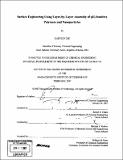| dc.contributor.advisor | Robert E. Cohen and Michael F. Rubner. | en_US |
| dc.contributor.author | Lee, Daeyeon | en_US |
| dc.contributor.other | Massachusetts Institute of Technology. Dept. of Chemical Engineering. | en_US |
| dc.date.accessioned | 2008-11-10T19:53:13Z | |
| dc.date.available | 2008-11-10T19:53:13Z | |
| dc.date.copyright | 2007 | en_US |
| dc.date.issued | 2007 | en_US |
| dc.identifier.uri | http://dspace.mit.edu/handle/1721.1/38979 | en_US |
| dc.identifier.uri | http://hdl.handle.net/1721.1/38979 | |
| dc.description | Thesis (Ph. D.)--Massachusetts Institute of Technology, Dept. of Chemical Engineering, 2007. | en_US |
| dc.description | Includes bibliographical references (p. 184-204). | en_US |
| dc.description.abstract | Surface engineering of a variety of materials including colloidal particles and porous membranes has been achieved by using layer-by-layer assembly of pH-sensitive polymers and nanoparticles. In the first part of this thesis, hydrogen-bonded multilayer coatings comprising poly(acrylic acid) and polyacrylamide were used to functionalize spherical colloidal particles. Multilayer-modified colloids showed an excellent resistance to cell adhesion. Hydrogen-bonded multilayer coatings on microspheres also could be utilized as templates for in situ nanoparticle synthesis enabling the formation of nanoparticle-loaded hollow microcapsules. Silver nanoparticle-loaded multilayer coatings were created on magnetic microspheres to create antibacterial agents that can be manipulated using a magnetic field. In the second part, the surfaces of track-etched polycarbonate membranes were functionalized with multilayer coatings that undergo discontinuous swelling transition. Multilayers comprising poly(allylamine hydrochloride) and poly(styrene sulfonate) were deposited at a high pH condition (pH > 9.0). These multilayer-modified membranes exhibited hysteretic gating behavior that could be useful for the separation of pH-sensitive materials such as proteins. | en_US |
| dc.description.abstract | (cont.) The growth and swelling behavior of the multilayers in the cylindrical pores of TEPC membranes were also investigated. Heterostructured magnetic nanotubes could be created by further modifying the multilayer-coated TEPC membranes. These magnetic nanotubes were utilized for the separation and controlled release of anionic molecules including active pharmaceutical ingredients. In the last part of this thesis, all-nanoparticle thin film coatings were created by sequentially depositing oppositely charged nanoparticles. The fundamental investigation of all-nanoparticle multilayers revealed that a narrow processing window exists in which multilayers of oppositely charged nanoparticles can be assembled in a true layer-by-layer manner. It was also demonstrated that structure and properties of all-nanoparticle thin films could be varied by controlling the assembly conditions. All-nanoparticle thin film coatings consisting of titanium oxide and silica nanoparticles exhibited potentially useful antifogging, antireflection and self-cleaning properties. | en_US |
| dc.description.statementofresponsibility | by Daeyeon Lee. | en_US |
| dc.format.extent | 204 p. | en_US |
| dc.language.iso | eng | en_US |
| dc.publisher | Massachusetts Institute of Technology | en_US |
| dc.rights | M.I.T. theses are protected by
copyright. They may be viewed from this source for any purpose, but
reproduction or distribution in any format is prohibited without written
permission. See provided URL for inquiries about permission. | en_US |
| dc.rights.uri | http://dspace.mit.edu/handle/1721.1/38979 | en_US |
| dc.rights.uri | http://dspace.mit.edu/handle/1721.1/7582 | en_US |
| dc.subject | Chemical Engineering. | en_US |
| dc.title | Surface engineering using layer-by-layer assembly of pH-sensitive polymers and nanoparticles | en_US |
| dc.type | Thesis | en_US |
| dc.description.degree | Ph.D. | en_US |
| dc.contributor.department | Massachusetts Institute of Technology. Department of Chemical Engineering | |
| dc.identifier.oclc | 166345968 | en_US |
